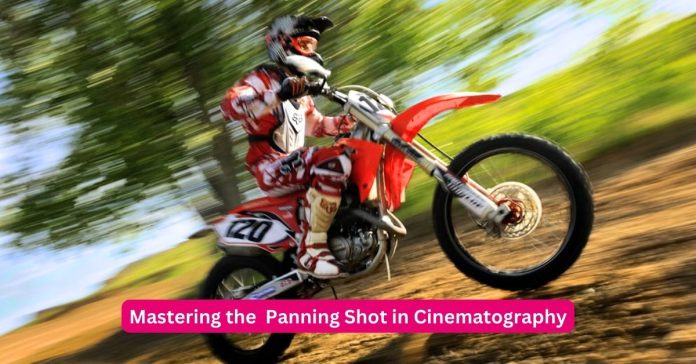Cinematography is a delicate craft that blends technical expertise with creative artistry to bring stories to life on the big screen. Among the plethora of techniques available to filmmakers, the panning shot stands out as a fundamental tool for capturing dynamic motion and emphasizing spatial relationships within a scene. Whether used to follow a character’s movement, reveal a breathtaking landscape, or convey a sense of urgency, mastering the panning shot is essential for any aspiring cinematographer. In this comprehensive guide, we delve deep into the intricacies of the panning shot technique, exploring its history, principles, applications, and tips for achieving cinematic excellence.
Panning Shot Technique:
Understanding the Panning Shot:
The panning shot is a camera movement technique in which the camera rotates horizontally from a fixed position. This movement allows filmmakers to track subjects moving across the frame or to explore the surrounding environment while maintaining a central point of focus. Unlike static shots, which can feel static and devoid of energy, panning shots inject dynamism and fluidity into a scene, drawing viewers deeper into the narrative.
Historical Evolution:
The origins of the panning shot can be traced back to the early days of cinema when filmmakers experimented with ways to enhance the visual storytelling experience. In the silent film era, directors such as D.W. Griffith pioneered techniques for moving the camera to create a sense of movement and perspective. As technology advanced and cameras became more versatile, the panning shot evolved into a staple technique in the cinematographer’s toolkit.
Principles of Panning Shot:
At its core, the panning shot relies on the principle of controlled camera movement to guide the viewer’s attention and enhance the emotional impact of a scene. To execute a panning shot effectively, cinematographers must consider several key factors:
- Smooth Movement: The key to a successful panning shot lies in achieving smooth, fluid movement without any jerks or jitters. This requires precise coordination between the camera operator and any equipment used, such as a tripod or gimbal.
- Framing and Composition: Like any camera movement technique, framing, and composition are crucial aspects of a panning shot. Cinematographers must carefully consider the placement of subjects within the frame and the overall composition to ensure visual coherence and storytelling clarity.
-
Speed and Timing: The speed and timing of the pan can greatly influence the mood and pacing of a scene. A slow, deliberate pan can create a sense of tension or anticipation, while a rapid pan can convey urgency or excitement.
Applications in Cinematic Storytelling:
The panning shot finds wide-ranging applications in cinematic storytelling, serving both practical and aesthetic purposes. Some common uses of the panning shot include:
- Following Action: Panning shots are often used to follow characters as they move through a scene, allowing filmmakers to maintain visual continuity and keep the audience engaged in the action.
- Revealing Landscapes: Panning shots are ideal for capturing sweeping landscapes and panoramic vistas, allowing viewers to immerse themselves in the beauty of the setting.
- Creating Transitions: Panning shots can be used to create smooth transitions between different locations or scenes, helping to establish spatial relationships and narrative coherence.
- Emphasizing Details: By panning across a scene, cinematographers can draw attention to specific details or points of interest, guiding the viewer’s gaze and enhancing storytelling impact.
Tips for Mastering the Panning Shot:
Achieving mastery of the panning shot technique requires practice, patience, and attention to detail. Here are some tips to help aspiring cinematographers hone their skills:
- Start Slow: Begin by practicing slow, controlled pans to develop a steady hand and a keen sense of framing and composition. Focus on maintaining smooth movement and avoiding abrupt changes in direction.
- Use Support Equipment: Investing in quality equipment such as tripods, gimbals, or fluid heads can greatly enhance the stability and precision of your panning shots. Experiment with different setups to find what works best for your specific needs.
- Plan Your Shots: Before shooting, take the time to plan out your panning shots carefully, considering factors such as framing, composition, and camera movement. Visualize the desired outcome and communicate your vision to your team to ensure a smooth execution on set.
- Pay Attention to Timing: Timing is critical when executing a panning shot, as it can greatly impact the emotional resonance of a scene. Experiment with different speeds and rhythms to find the pacing that best suits the mood and tone you want to convey.
-
Practice Continuously: Like any skill, mastering the panning shot technique requires consistent practice and experimentation. Take every opportunity to shoot and refine your technique, seeking feedback from peers and mentors to help you improve.
Conclusion:
The panning shot is a versatile and powerful technique that can elevate the visual storytelling experience in countless ways. By understanding the principles behind this technique and practicing diligently, cinematographers can harness the full potential of the panning shot to create compelling and immersive cinematic narratives. Whether used to follow a character’s journey, showcase breathtaking landscapes, or emphasize key moments, the panning shot remains an essential tool in the filmmaker’s arsenal, capable of capturing the imagination and emotions of audiences worldwide.
Must Read:
- Mastering the Over The Shoulder Shot Technique in Cinematography: A Comprehensive Guide
- Mastering the Dutch Angle Shot: Techniques, Examples, and Impact in Cinematic Storytelling
- Mastering the Medium Shot Technique in Cinematography: A Comprehensive Guide
- Cinematic Majesty of Birds Eye Shot: Examples from Iconic Films
- Exploring the Power of the Extreme Long Shot in Cinematography




